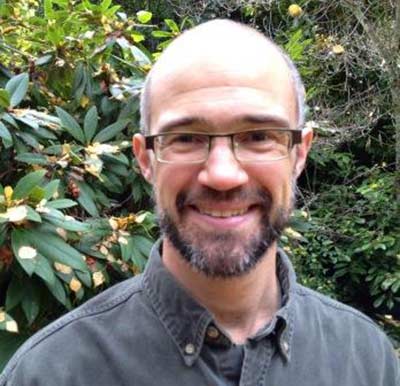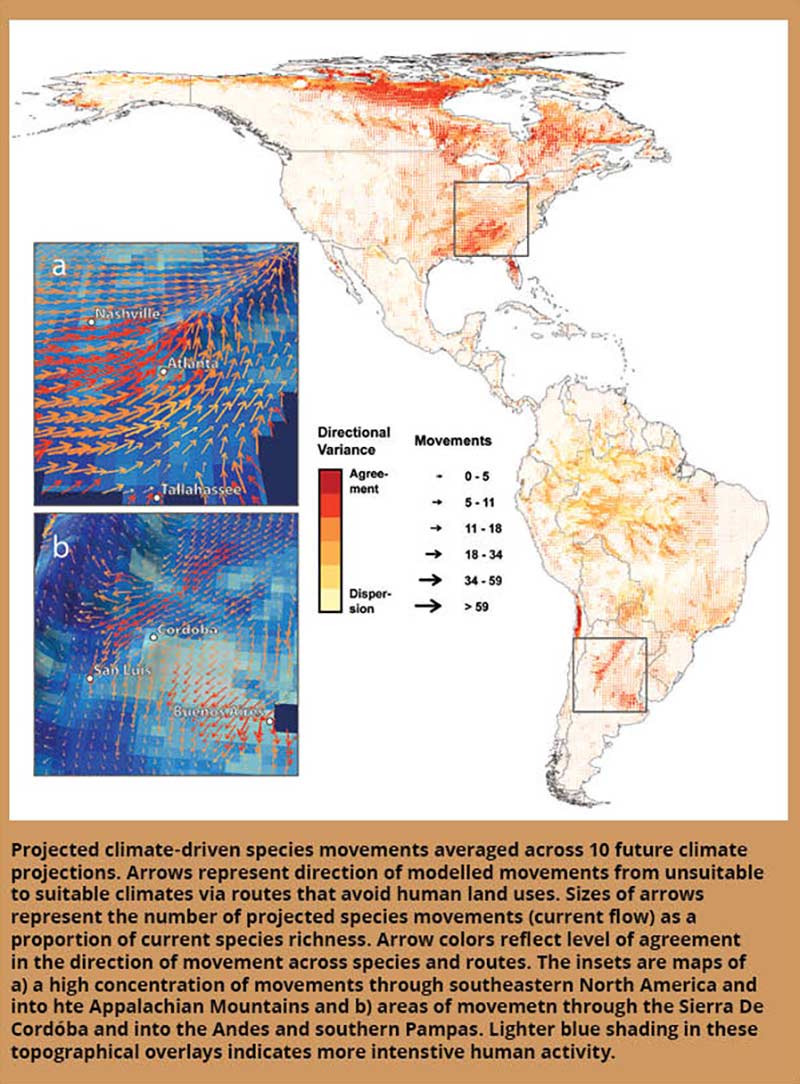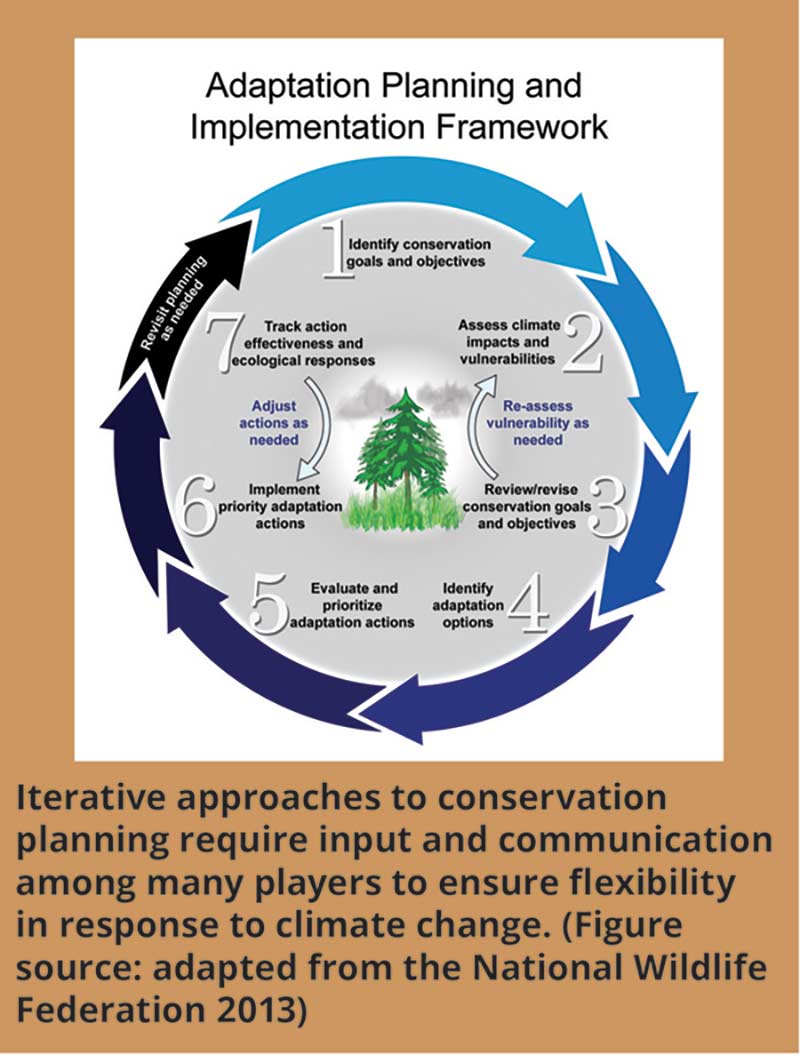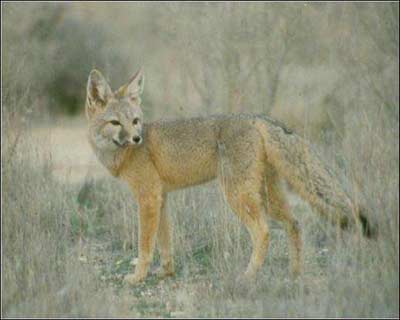Species movement to adapt to changing environments is not new. Very generally speaking, how is the movement of species due to modern climate change different from what it has been historically?

Dr. Josh Lawler
Although current rates of climate change are very fast, and much change is predicted, if you look back through time, there have been periods in which we have had large changes in climate and large shifts in species distributions. We have the best records for plants (because we have fossil pollen from lake sediments), which we know have moved across large areas, seemingly relatively quickly—although it is now thought that some of this movement was really expansion from small isolated populations. We do not have good records of how fast animals have moved in the distant past, though, largely because we do not have very good fossil records for most animals. So we do not have a really good idea of how quickly things have moved in the past but we are finding that plants and animals are moving faster today than we thought they were. Studies that have come out in the last seven years have shown that species are moving more quickly than previous studies indicated.
For much of your research on this topic, you’ve applied a coarse-filter approach, rather than looking the species level, but can you share one or two examples of species that are already experiencing significant movement due to climate change, and those that are projected to move?
Some of the most well studied organisms, in terms of range shifts, tend to be birds, butterflies, and plants. In the U.S., early studies by Camille Parmesan showed that butterfly populations in southern California were going extinct and appeared to be moving north. That was some of the earliest work done to document [climate-driven] range shifts. Similar studies of butterflies in Britain have shown shifts to the north. Studies of birds in the U.S., Britain, and elsewhere have also demonstated shifts toward the poles. Alpine plants and plants in mountainous regions in Europe have been fairly well studied, and shifts to higher elevations have been well documented.
One species that has been fairly well-studied in the U.S. is the pika. It has been shown that a number of lower elevation populations of pikas have disappeared. One would expect this as it gets warmer because pikas require snowpack in the winter and cooler temperatures in the summer—conditions that are becoming less common at lower elevations in the western US as temperatures warm.
What have been some of the cascading effects of those shifts, or is it too early to see that?
We are bound to see new interactions among species and changes in ecosystems because of species movements. To date, there aren’t many studies that explicitly look at the cascading effects of climate-driven species movements on communities, but we do expect such effects. Researchers are finding that there are time lags in species responses to climate change [that is lags in the movement of some species in response to climate change]. Although many species are moving in ways that are consistent with changes in climate, others are not. One study that explored climate responses of two alpine plants in the U.S. found that neither showed a shift in their distributions. The researchers showed that although survival and recruitment was lower in southern populations, this was off-set by increased growth of individual plants in the south. Thus, the plants seemed to be able to compensate for lack of reproduction with higher growth rates. This, however is only a temporary solution to the problem of warming—as the older plants die, they will not be replaced . Other species may not need to move because they can adapt or because they can tolerate a much wider range of climatic conditions that we would expect.
You contributed to a literature review in the journal Frontiers in Ecology in which I read that some species movement can be indiosyncratic, even counterintuitive. Can you give an example?
A recent paper which looked at tree species in the western U.S. found that some species seemed to be moving downslope to lower elevations, which is not what one would expect. But once researchers looked further into the mechanisms, they found that at the upper extent of those species’ ranges, reduced snowpack was driving the upper range limit down. At the lower extent, the movement was explained by changes in moisture levels. So, even though the species didn’t show the typical shift to higher elevations, they did appear to be moving in response to climate change.
How would you describe the state of science related to understanding species movement because of climate change?
Although it has come a long way in the last ten years, we still have much to learn. The information comes from a number of different places. One is from observing and documenting range shifts–knowing where species have been in the past and finding out where they are today. Other information comes from paleo records–knowing how species moved in the distant past. A third source is the kind of modeling I do, projecting potential future shifts. This area has advanced relatively quickly, but there is still a lot of uncertainty associated with these types models. As we try to predict where, how much, and how fast species will move in the future, we rely on both climate models and biological models, both of which have associated uncertainties. Future work will reduce these uncertainties, but they will always be there—and that’s okay. We make decisions based on limited information all the time. Economic policies, health-care decisions, and even decisions to go to war are often made on far less certain information, projections, and model outputs.
How does the amount of information about climate-driven terrestrial species movement compare to that of aquatic species?
More work has been done on terrestrial species, but the work on freshwater water fish and marine species is growing. This includes work by Malin Pinksy and Dan Isaak.
What do you see as the most critical knowledge gaps?
One of the key knowledge gaps is in understanding what controls species’ current distributions–why they are where they are now. If we knew more about how climate determines species’ current distributions, we would be able to do a better job projecting how changes in climate will affect them.
No matter how quickly the science advances, there will always be responses that we cannot anticipate. For example, we don’t know how interactions among species are going to change as the climate changes. As the climate warms, we may see two competing species that previously coexisted, unable to do so. One may out-compete the other for some reason. Those are the kinds of things we are not going to be able to predict for most species, even with better models and more ecological knowledge. Our basic knowledge about the ecology and natural history of species is perhaps one of the biggest things holding us back.
Climate-driven species movement seems like a Pandora’s Box of a research topic, given the degree of unpredictability and the multitude of factors. What do you find to be the greatest challenge in approaching this topic?
I think the greatest challenge is indeed the uncertainty in the modeling. I come at the modeling from the perspective of a conservation planner—because I’m interested in how prioritize areas to protect biodiversity. One of the greatest challenges I face is interpreting the model outputs—with all of their uncertainties—and recommending how they can be used for conservation planning and species and ecosystem management.
A year ago, you and colleagues published a paper in Ecology Letters in which you examined how the distributions of over 2900 vertebrate species (birds, mammals and amphibians) will shift because of climate change, and where those species’ movements will conflict with human land use. For the benefit of our readers, can you summarize your findings?
We modeled potential shifts in the distributions of 2900+ species, and we looked at how each species would have to move across the landscape in North and South America to track the changing climate. For every place within the current range of a species, we mapped a route that would take them to the nearest suitable climate in the future. Those routes had to follow the suitable climate, but also avoid areas that were heavily impacted by humans, like agricultural areas, and areas with major highways and development.
When we did that for all those species and overlaid those potential movement routes, we found that there were certain places where there will likely be a great deal species movement, either because the climate will force species to move or because the species will be funneled through particular areas by the way humans have used the landscape.
A number of these places—these highways of movement–popped out on the maps we created. In the U.S., one of the clearest routes was in the southeast, where there was a lot of projected movement up into the Southern Appalachians and along the Appalachians, presumably to allow species to reach cooler climates. We saw similar concentrations of movement in South America. In the Amazon, we saw lots of movement to the west and up into the Andes, following the river corridors defined by the Amazon and its tributaries. In southeastern Brazil, we saw lots of movements to the southeast that were were being channeled by development. In Argentina, there is a clear path of movement down through the Pampas and up into the Andes. In one analysis, we found movement up through the western U.S. along a corridor all the way from Mexico up into the Yukon. Those movement paths were largely defined by where there were mountain ranges and protected lands that weren’t as developed, as well as how the climate was directing movement.

Did any of your finding surprise you?
We were surprised at how clear some of these pathways were. We expected to see lots of general northward movements in the Northern Hemisphere and general southward movement in the Southern Hemisphere. We also expected to see movements toward higher elevations. But we did not expect to see these concentrations of movements in specific places.
In what ways do you see (or hope to see) your research being applied?
We have been working to integrate models (not necessarily from the paper in Ecology Letters, but similar models with similar datasets) into the planning process for selecting places to protect that would better help animals move in response to climate change. We’ve been working specifically with The Nature Conservancy to integrate climate-change considerations into a tool for prioritizing large land deals.
Where is this research headed? What’s next?
My lab has gone in three different directions since completing some of the larger-scale, Western Hemisphere work we’ve talked about here. One of those directions has been to work at a finer spatial scale. We have been working in the Pacific Northwest at a much finer resolution to do the same kind of species distribution modeling for birds, mammals and amphibians.
Another direction is that we have started using a different kind of model for individual species. We have done work on endangered species, such as the San Joaquin kit fox (Vulpes macrotis mutica), the desert tortoise (Gopherus agassizii), and the Black-capped Vireo (Vireo atricapilla), the Red-cockaded Woodpecker (Picoides borealis).
We have used very sophisticated population models that track individuals through space and time as they respond to climate change and other factors. We have used those models to look at how individual populations of these species in particular locations would respond to a changing climate. This kind of modeling takes a lot more data and a lot more work, and you can only do it for a handful of species for which you have a lot of information. So that is one direction in which we have gone: trying to build more sophisticated, arguably better models that should be able to better predict potential future changes.
The third direction we have taken is to look for alternatives to doing this kind of modeling to use in the conservation-planning process. There are managers and planners who are a bit wary of all of the uncertainty and want something not based on model projections. We have been looking at different approaches that involve identifying climate refugia– places that might be suitable in the future for lots of species, places nearby in the landscape species might go to, or places that will change less in a changing climate. You can identify these refugia using the types of models we’ve been using, but you can also identify them using topography. For example, you can look at where there are north-facing slopes (in the northern hemisphere) or higher elevations that are colder now than any place in the surrounding landscape, because they’re likely to still be colder than anything in the landscape in the future even if they are warmer than they are today. There are also approaches that use current climate maps to identify those places. So you can do that without using model projections.
There are other approaches that people have suggested for protecting species in a changing climate. For example, some have suggested that we protect a diversity of environments– assuming that a diversity of soil types and topographies will provide or a diversity of species in the future. That is an approach that has been pioneered by Mark Anderson at The Nature Conservancy.
We have also been working on connectivity modeling that is based on current climate gradients and not projected future climates. This modeling attempts to connect intact patches of land that are slightly warmer to ones that are slightly cooler in ways that will allow species to avoid going through areas that are heavily impacted by people and that avoid crossing steep climate gradients.
So these are some of the things that we’ve been doing that don’t involve model projections but are also for the purpose of planning to protect diversity in a changing climate.
So the concerns of planners and managers about the uncertainty of projection models drove this direction of your research. How did you come to know that they were leery of projection models?
Largely from working with them. For the finer scale modeling project we’re doing in the Pacific Northwest, we work with scientists and managers from the Idaho Department of Fish and Game, the Washington Department of Fish and Wildlife, and The Nature Conservancy. Through that project, we were able to learn what people were thinking and worrying about [with respect to projection models]. I was also, personally grappling with what to do with all this uncertainty. The more working groups and task-forces I participated in that involved managers, and the more talks I gave to groups of people in local and regional management positions, the more I could see that people were concerned.
Species movement is not going to be restricted by regional and national borders. To what degree is there international cooperation regarding research of this topic?
There is plenty. One of the first international collaborations that made a big splash put together the work groups in Central America, South Africa, and Europe. They collaborated to write a paper that became one of the first attempts project climate-caused extinction rates. They used range shift projections to estimate how many species would actually run out of suitable climate habitat. There are also people, like Walter Jetz at Yale, whose work involved global modeling.
The Intergovernmental Panel on Climate Change is the best example of scientists coming together to summarize information that is out there—not necessarily to do the modeling, but to summarize modeling outputs.
Is there any type of central database where practitioners can find information related to climate-driven species movement?
There is no one-stop shopping, but there are places practitioners can go to get information. There is a data repository called Data Basin which has a lot of maps of range shifts and changes in vegetation that have been predicted for some places. In addition, my lab developed a tool called Climate Wizard. You can use it to explore how climate has changed or is going to change in any particular place on the globe.
Climate change will cause invasive species to move, too. Many of our readers are land planners and designers. Some may find themselves in a position where they are being asked to consider non-native species. How can they find out if species are likely to become invasive as the climate changes?
[Climate-driven movements of invasive species] are hard to model, because introduced species don’t necessarily behave the way they do in their native range. There is evidence that some invasives will likely fair better than native species as the climate changes.
Were invasive species factored into your study “Projected climate-driven faunal movement routes”?
We didn’t focus on invasive species. But you are right. If one factors in big drivers that might change habitat, such as changes in fire regimes, changes in hydrology, outbreaks of disease, etc., the picture might change quite a bit. There are people working on those particular climate-driven responses. These are things that could be incorporated in recent models to make them potentially more accurate and useful.
Let’s talk about the application of this type of research. The “Ecosystems, Biodiversity, and Ecosystem Services” chapter of the National Climate Assessment (for which you were a lead author), concludes with recommendations for adaptation planning. If you sat down to lunch at a table full of natural resource managers and policy makers, and you had only a couple of minute to say something to them about adaptation planning, what would you say?

First, I would suggest trying to develop a general understanding of what climate change might mean for the particular resource or area that is being managed. Is it projected to get hotter and wetter? Hotter and drier? What will that mean for the plants? The animals? The landscape? This could be fairly simple. It could mean understanding that there will likely be more fire, or that it’s likely to be dryer so there will be more droughts. Having an idea of the potential impact on and the vulnerability of, the things one is managing is the first step.
Then, I would suggest reconsider current management actions and management goals and objectives. It may not be possible to manage for species X anymore because of climate change. Or it may no longer make sense to manage water in the way it is currently managed.
After that, I would recommend identifying the potential management options. What will could be done differently now in the face of these potential impacts? That means coming up with strategies, which may involve some new management approaches, old techniques used in a different way, etc.
The next step would be to apply some of those strategies and monitor the system or species as the climate changes. Some of those strategies are going to be experiments, and the climate may or may not change as projected, so those strategies may need to be adjusted. Being very flexible in terms of management, and responding to the way these experiments turn out and the way the climate is changing will be critical.
One of the adaptive strategies listed among those in the National Climate Assessment is assisted migration. What is your opinion on assisted migration?
It is a tool that we should keep in our toolbox, but one we will have to use very carefully. There are going to be species that will need to be picked up and moved if we want to keep them from going extinct. In that case, we’re going to have to think the process through carefully and weigh the potential consequences of the new introduction or translocation against the consequence of losing the species. It will be hard to make those decisions.

Lawler’s team is studying the San Joaquin kit fox (Vulpes macrotis mutica) ©Brian Cypher
The conclusion of your paper in Ecology Letters states that “human activities on the landscape have the potential to greatly facilitate or inhibit” climate-species movement. I’d think that Leaf Litter readers can play a key role in facilitating movement. What advice do you have for them?
Facilitating species movements is often thought of in terms of big projects like the Yellowstone to Yukon Conservation Initiative or wildlife crossings over highways, but smaller efforts such as making landscapes more permeable by having more fence rows in agricultural fields, letting fields go fallow in certain patterns, or designing residential areas with more native vegetation that is resilient to climate change all have the potential to facilitate movements.

